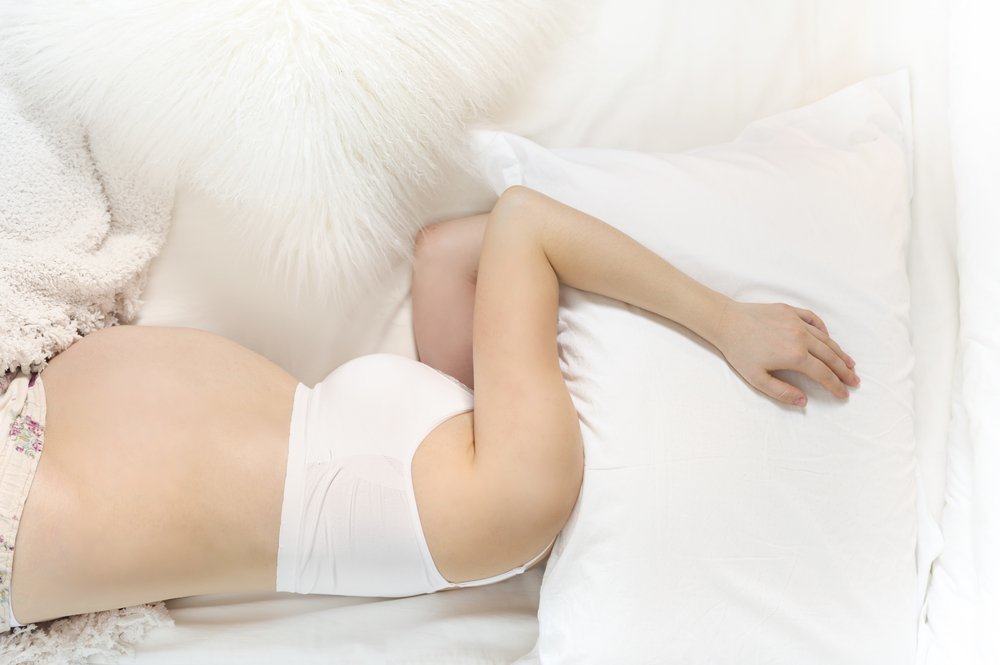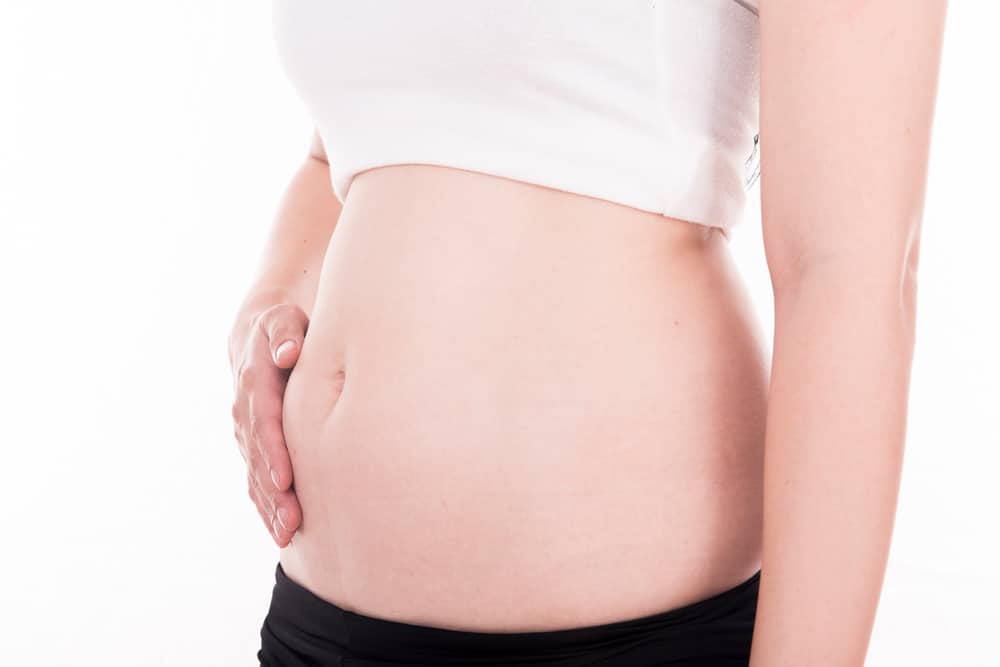Contents:
- Medical Video: Asthma how-to: How to use an inhaler with a spacer and mouthpiece
- What is a nebulizer?
- Nebulizers have many types
- 1. Nebulizer compressor
- 2. Mesh Nebulizer
- 3. Ultrasonic Nebulizer
- How to use a good and correct nebulizer
- The way to treat a nebulizer is to last a long time and not be damaged quickly
- Besides asthma, a nebulizer can also help with these health problems
- 1. COPD
- 2. Bronchiolitis
- 3. Bronchiectasis
- 4. Cystic fibrosis
- 5. Sinusitis
- Then, what is an inhaler?
- What are the types of inhalers for asthma?
- Types of asthma inhalers based on how they are used
- Types of asthma inhalers based on their shape
- How to use the right and effective inhaler
- How to clean the inhaler
- There are several side effects of using an inhaler
Medical Video: Asthma how-to: How to use an inhaler with a spacer and mouthpiece
Asthma is a chronic disease that cannot be cured. However, the symptoms can be controlled and preventedby using a breathing apparatus in the form of a nebulizer or inhaler. These two inhalers can also immediately cope with a relapsing asthma attack. Although the function looks similar, how to use a nebulizer and a different asthma inhaler, you know!
What is a nebulizer?
Nebulizer is a machine that converts liquid medicine into steam to be inhaled into the lungs. This breath aid is usually run with electric or battery power. By using a nebulizer, you can breathe more easily.
Nebulizers are usually used as a therapy for chronic asthma treatment, both for children and adults. This is because compared to the inhalers, the medicinal vapor particles produced by the nebulizer are so very small that the drug can absorb more quickly into the targeted part of the lung.
In addition to the treatment of asthma, this tool can also be used for sufferers of chronic obstructive pulmonary disease (COPD), pneumonia (lung infection), and severe allergic reactions.
The nebulizer device consists of an air compressor machine, a small container for liquid medicine, and an elastic hose that connects the air compressor to the medicine container. At the top end of the medicine container is a funnel or mask that is used to breathe the steam mist.
Nebulizers have many types
There are many types and models of this breathing apparatus, although the function remains the same. The type you choose will affect the duration of treatment, the particle size of the drug you can breathe in, portability (easy to carry or not), durability of the tool, and many other things.
The most common types of nebulizers are compressors, ultrasonic and mesh.
1. Nebulizer compressor
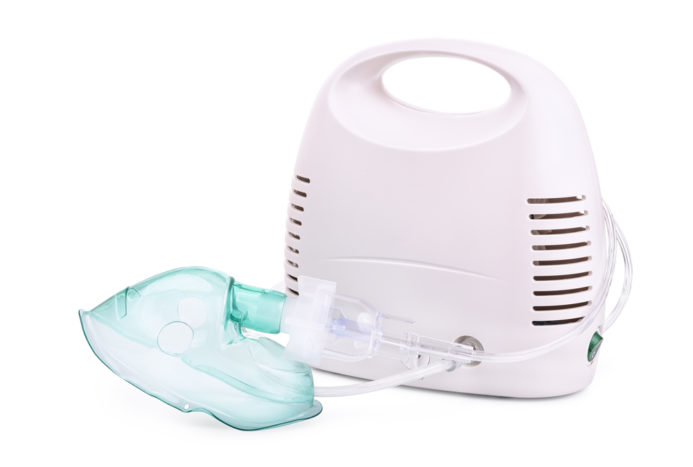
This type of compressor produces high-pressure gases which are flowed very quickly to break up the liquid medicine until it becomes a form of steam. Compressors are usually cheaper than other types, but tend to be more wasteful because they use electricity. This device is also noisy because it produces the engine buzzing sound.
The duration of use of the compressor for one treatment can take around 8-20 minutes.
2. Mesh Nebulizer
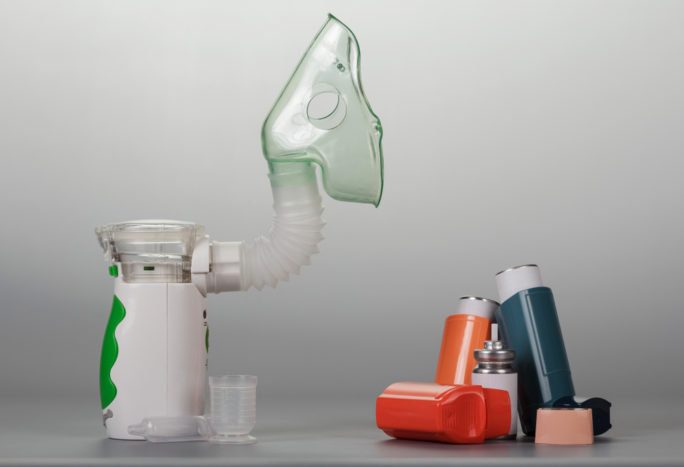
The mesh nebulizer produces electricity or ultrasonic waves that vibrate liquid drugs through the mesh holes (material made of wire mesh or yarn). The result is very fine liquid droplets of liquid.
The mesh type is considered as a breathing apparatus with the fastest, most efficient and not noisy way of working. The operation uses a battery so it is practical to carry around. However, the price is more expensive than others.
3. Ultrasonic Nebulizer
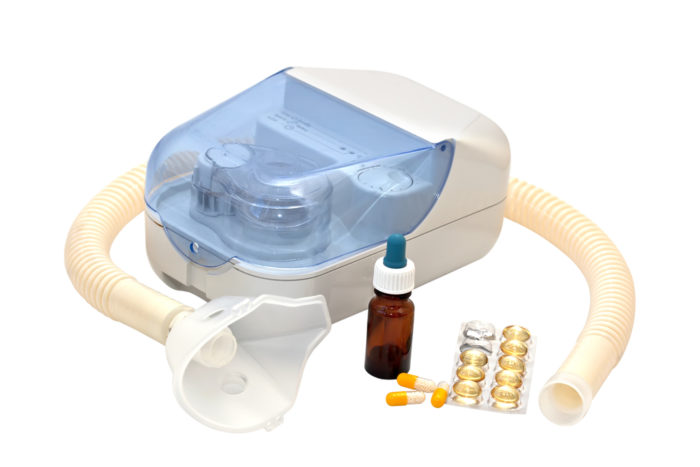
The ultrasonic type produces high frequency vibrations to convert liquid drugs into water vapor.The ultrasonic Nebulizer does not make noise, is small in size, and is easy to carry everywhere because it is operated by battery power. There is also an electric version that can be refilled (rechargeable).
Ultrasonic Nebulizers work faster than other types, which is about 6 minutes for one treatment. Even so, this tool is not efficient for changing suspension drugs or thick liquids.
How to use a good and correct nebulizer
How to use the right nebulizer allows the drug to seep into the lungs and work effectively to treat asthma. Following are the steps:
- Wash hands with soap under running water to prevent germs from entering the lungs through the hands that touch the nebulizer.
- Prepare the medicine to be used. If the medicine has been mixed, pour it directly into the nebulizer medicine container. If not, enter one by one using a pipette or syringe.
- Add saline fluid if needed and prescribe the doctor.
- Connect the medicine container to the machine and also the mask to the top of the container.
- Attach the mask to the face to cover the nose and mouth. Make sure the edges of the mask are well sealed with the face so there is no steam coming out of the sides of the mask.
- Turn on the engine then inhale with your nose and slowly remove it through your mouth.
- You can end it when there is no more steam coming out. This is a sign that the drug is up.
As a preventive therapy for asthma attacks, the nebulizer can be used for 20 minutes for 1-2 times a day. If to relieve an asthma attack, this tool can be used every 4 hours depending on the severity of your asthma symptoms.
The way to treat a nebulizer is to last a long time and not be damaged quickly
Many people who do not understand how to use a nebulizer and do not realize they are already damaged. Therefore, you must know how to treat it so that it can still effectively control your asthma.
The nebulizer drug steam cleaner must be cleaned every time it is used to prevent the growth of germs in the machine that can enter the lungs. Here's how to clean it:
- After finishing using, always wash the medicine container and mask with dish soap and rinse with hot water. Try to clean it without missing anything.
- Wipe clean each part of the nebulizer until it is completely dry. To dry faster, you can also attach each part of the nebulizer to the machine and turn it on. The air released from the engine helps dry the tool quickly and practically.
- Make sure all parts are completely dry before storing them and use them again.
In addition to cleaning, you also need to sterilize the breathing apparatus every other day after use. How:
- Soak the nebulizer parts (except the mask) in the basin that has been filled with 3 cups of hot water mixed with a spoon of runny white vinegar.
- Let stand for one hour or according to the instructions in the packaging box.
- After that, dry it until it is completely dry. After that, reattach the parts of the nebulizer to the machine and turn on the appliance. Make sure all parts are completely dry before storing them.
After cleaning and sterilizing, make sure to keep the tool in accordance with the instructions to keep it durable and continue to function properly.
The hose needs to be replaced regularly to make it more hygienic and ensure that you do not breathe harmful germs.
Besides asthma, a nebulizer can also help with these health problems
1. COPD
Chronic obstructive pulmonary disease (COPD) gradually attacks the lungs, usually caused by smoking. This disease is characterized by symptoms of respiratory distress and obstructed breathing.
Breath can be inhibited as a result of a combination of airway diseases such as chronic bronchitis, damage to the air bag in the lungs, and refractory (severe) asthma.
Although COPD patients generally experience an incurable airway constriction, the use of bronchodilators has the potential to alleviate the complaint.
Therefore, a nebulizer with bronchodilators can be used to treat acute complaints or to prevent COPD from worsening.
2. Bronchiolitis
Bronchiolitis is inflammation and swelling of the small airways (bronchioles) due to viral infections. This condition is often found in infants and can be one of the risks of future asthma. The doctor or nurse may recommend nebulizer to treat bronchiolitis, depending on the conditions and needs of each.
3. Bronchiectasis
Bronchiectasis characterized by airways that are injured and inflamed, and filled with thick mucus. This can increase the risk of bacterial infection.
Well, nebulizer is a tool that can be used to clean mucus. That way, you more easily remove mucus and drugs for bacterial infections become more easily absorbed.
4. Cystic fibrosis
Cystic fibrosis or cystic fibrosis is a genetic disease that interferes with the body's ability to control the movement of salt and water between cells. As a result, it forms a very thick mucus in the lungs and digestive system. This makes it difficult for you to breathe and increases the risk of lung infection.
The Nebulizer will deliver the drug efficiently and destroy the mucus clots or overcome the symptoms of other cystic fibrosis. Cystic fibrosis drugs that can be used inside nebulizer are bronchodilators, corticosteroids andornase alpha enzymes.
Treatment with a nebulizer not only relieves breathing, but also regulates mucus production and prevents infection from getting worse.
5. Sinusitis
Sinusitis ais an inflammatory condition in the area of the nose and sinuses. According to various reports, ultrasonic nebulizer powerful enough to reduce sinusitis symptoms such as nasal congestion or pain in the area of the nose and face. This tool is even said to be able to overcome bacterial infections in 76 percent of patients given antibiotics through this steam engine.
In a survey conducted on patient users nebulizer at home, proven that benefits nebulizer far greater than any potential risk. Nebulizer itself can be a very helpful tool in controlling chronic lung disease, and can help patients save even more
Then, what is an inhaler?
Similar to a nebulizer, an inhaler is a spray (aerosol) that contains drugs to relieve asthma symptoms. Certain types of inhalers can also help prevent recurrent asthma attacks.
Unlike the nebulizer, which is quite large and heavy, the inhaler spray is light and compact so it's easy to carry anywhere. The way to use it is also practical, just by pressing the medication tube and breathing the steam through the funnel. But sometimes, inhalers are more difficult to use for certain groups, such as infants, toddlers, or adults with severe asthma who need a stronger / bigger dose.
What are the types of inhalers for asthma?
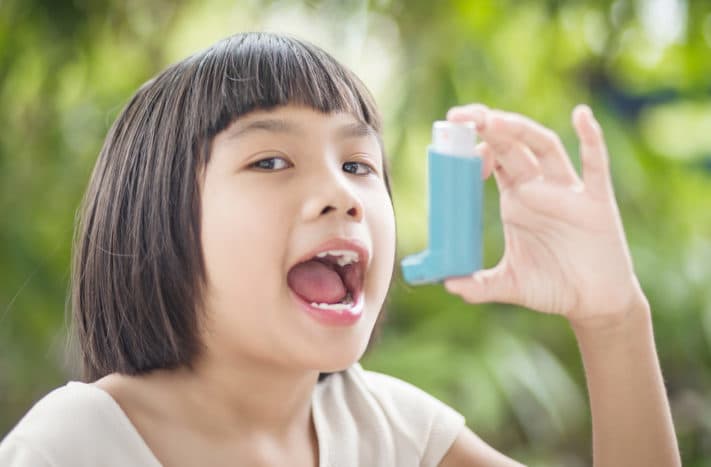
There are many types of asthma inhalers, divided into several categories and functions that are different ways of use, shape (model), and dosage based on the severity of the symptoms.
Types of asthma inhalers based on how they are used
There are two types of asthma inhalers that are used based on how they are used, namely
- Inhalers are used every day. This inhaler is used twice a day to prevent asthma symptoms that might attack. The drugs in the inhaler work to prevent inflammation in the airways. This type of inhaler usually contains corticostreoid drugs such as beclomethasone, budesonid, fluticasone, and mometasone.
- Inhalers used when relapsing. IThis nhaler is used to relieve asthma attacks as soon as the initial symptoms occur. The drug that is usually used is bronchodilators. Bronchodilators consist of various types of drugs that work to relax the muscles of the tightening airway. That way, so that your breathing can return to normal.
Types of asthma inhalers based on their shape
There are two types of asthma inhalers that are used based on the shape (tool model), namely:
1. Pressurized measured dose inhaler (metered dosage inhaler)
This inhaler consists of a pressurized tube containing medicine and at the end there is a plastic funnel. When asthma recurs, you must quickly breathe in from this inhaler. That way the drug will also go directly into the airway and relieve symptoms.
If you use this inhaler, then you should note how many doses of medicine you have breathed. This type of asthma inhaler is sometimes not included in a dosage meter that makes you know how much medicine you breathe.
2. Dry powder inhaler
Unlike pressurized dosing inhalers, this asthma inhaler with dry powder is not an aerosol that you can directly breathe from the device. This inhaler can't spray medicine. So, the patient must breathe the powder quickly and strongly. Usually this inhaler is available for one breath, so it prevents excessive dosing.
To find out which one is better for you to use, you should discuss it with your doctor. Because, this also depends on the needs and conditions of each patient.
How to use the right and effective inhaler
How to use the inhaler correctly and more effectively is as follows:
- Sit or stand upright when using an inhaler.
- Beat the inhaler well before inhaling it.
- Take a quick breath as soon as you press the inhaler.
- Hold your breath for at least 10 seconds after inhaling it.
- If you need to use more than one sniff per dose, wait a few minutes between each suction. If you use bronchodilator medicine work fast, give a 3-5 minute pause. For other types, give a 1 minute pause.
- Pull and exhale slowly between each suction.
What needs to be remembered is that you cannot borrow from someone else's inhaler. Apart from being dirty and not necessarily clean, maybe the type of inhaler they have has the dosage and type of medicine different from what you have been using so far.
So as much as possible put and store your inhaler in an easily accessible place. Take the tool wherever you go to anticipate attacks that might recur in unexpected times and places.
How to clean the inhaler
It is important to keep the inhaler clean so that you do not breathe germs from the surrounding air that might stick to the surface of the mouthpiece. That is whymouthpiece the inhaler (mouthpiece where you place your mouth) needs to be cleaned every time you use it. Dry it naturally. Do not use a cloth to wipe it dry.
Here are some steps that can help you maintain the cleanliness of your inhaler.
- Remove the metal can from the inhaler (if your inhaler is metered-dose).
- Make sure there are no objects clogging the area.
- Rinse with warm water only on mouthpiece and the lid.
- Let it dry naturally throughout the night (do not use a cloth to wipe it dry).
- In the morning, put the metal can back into it. Install the lid.
- Do not rinse other parts.
The tips above can help you get far more medication from the inhaler. This will help you breathe better and reduce recurrence. Be sure to consult a doctor or pharmacist before changing doses or inhalers. They can show what you might do incorrectly.
There are several side effects of using an inhaler
Side effects of inhalers can include:
- Headache and dizziness
- Sleep disorders or insomnia
- Feeling pain in the muscles
- Runny or stuffy nose
- The mouth and throat feel dry
- Cough
- Hoarseness and sore throat
However, you need to be vigilant if the side effects below appear and immediately consult a doctor. Side effects of severe inhalers, namely:
- Chest pain, pounding and irregular heartbeat.
- Tremor.
- Anxiety symptoms.
- Decreased blood potassium levels, which can cause muscle weakness, feeling weak, and extreme thirst.
- Increase in blood pressure.
- Chest tightness and difficulty breathing.


